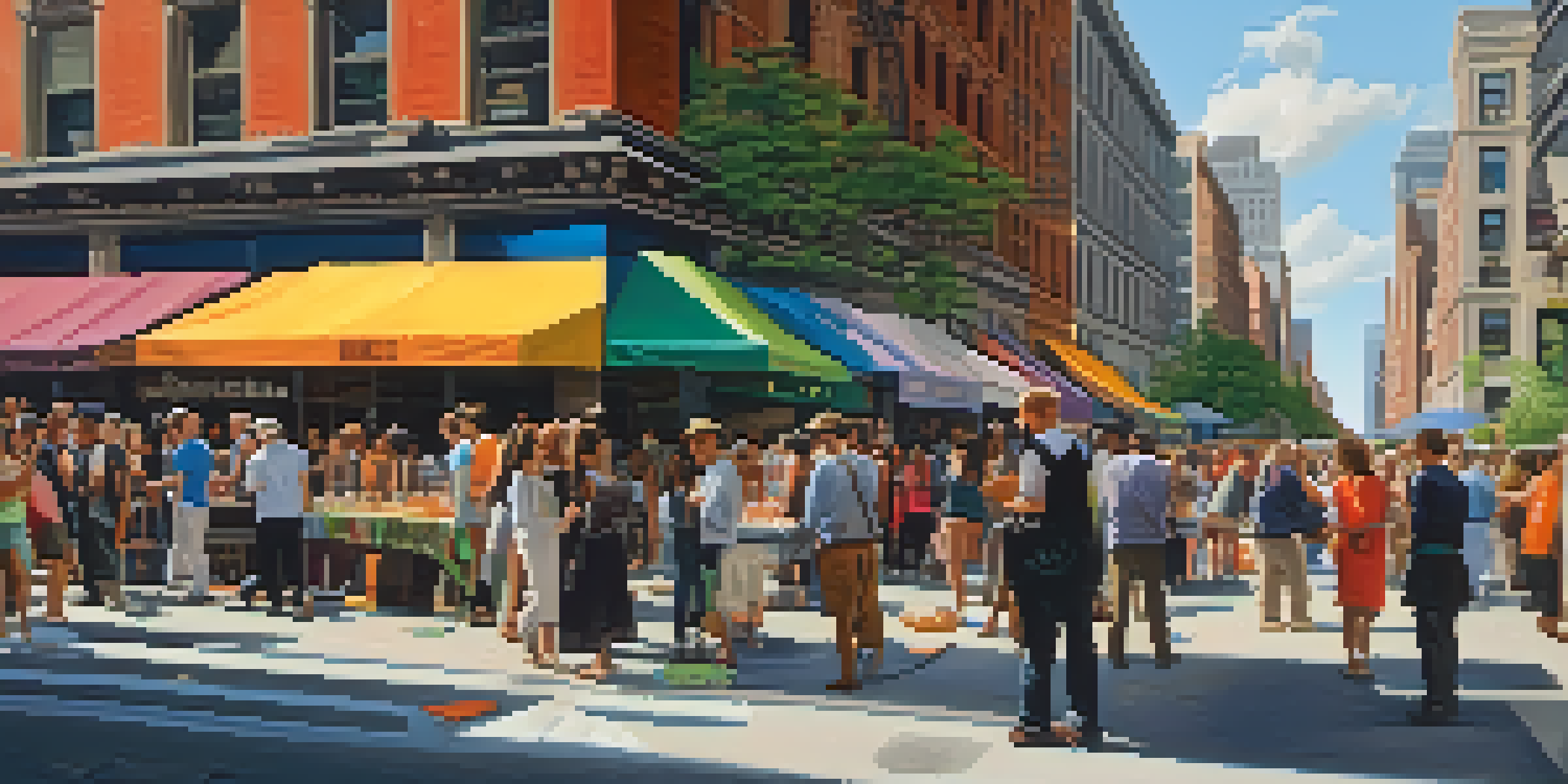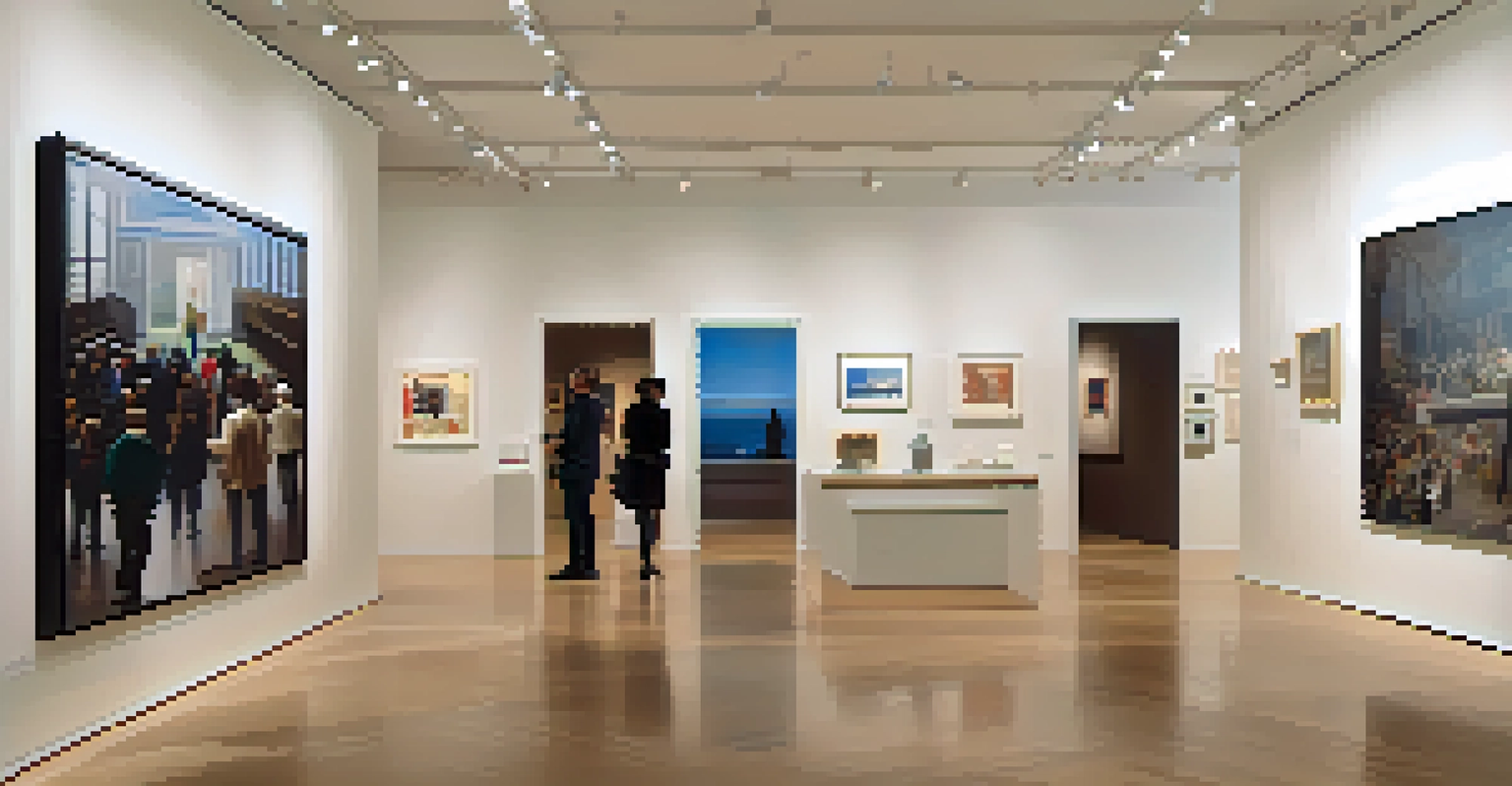The Impact of New York's Art Institutions on Global Culture

New York's Art Institutions: A Cultural Powerhouse
New York City is often hailed as a cultural capital of the world, and its art institutions play a pivotal role in this identity. From the iconic Museum of Modern Art (MoMA) to the sprawling Metropolitan Museum of Art, these institutions are not just galleries; they are vibrant hubs that attract millions of visitors each year. They serve as a platform for both established and emerging artists, showcasing a diverse array of works that reflect the complexities of contemporary society.
Art is not freedom from discipline, but disciplined freedom.
The influence of these institutions extends beyond their walls, as they curate international exhibitions that bring global art trends to the forefront. By promoting cross-cultural dialogues, they bridge gaps between artists and audiences, fostering a deeper understanding of various artistic expressions. This ability to connect different cultures through art is what truly sets New York's institutions apart on the world stage.
Moreover, the funding and resources available in New York enable these institutions to support groundbreaking research and innovative art programs. This not only nurtures local talent but also attracts international artists and scholars, creating a melting pot of ideas that enrich the global art scene. In essence, New York’s art institutions are not just local treasures; they are vital players in shaping global culture.
Exhibitions that Redefine Global Art Standards
One of the most significant contributions of New York's art institutions is their ability to host exhibitions that redefine global standards. For instance, exhibitions like the Whitney Biennial and the Armory Show showcase cutting-edge contemporary art, setting trends that ripple across the art world. These events not only highlight American artists but also invite international voices, creating a diverse tapestry of artistic expression.

As artists from various backgrounds come together, the exhibitions foster an environment where ideas can flourish and be exchanged. This exchange is crucial in a world that often struggles with cultural understanding, as art serves as a universal language that transcends barriers. When visitors engage with these works, they gain insights not only into the artists’ perspectives but also into the broader cultural narratives they represent.
Cultural Hubs Driving Global Art
New York's art institutions are vibrant cultural hubs that connect diverse artistic expressions and foster global dialogues.
Additionally, these exhibitions frequently challenge traditional notions of art, encouraging visitors to rethink their understanding of creativity. By pushing boundaries and introducing innovative formats, New York's institutions inspire other galleries around the world to follow suit. This ripple effect reinforces New York's position as a leader in the global art community.
Educational Programs: Nurturing Future Generations
New York's art institutions are also heavily invested in educational programs that nurture future generations of artists and art lovers. From workshops to lectures, these programs provide invaluable opportunities for young creatives to learn from established professionals. This commitment to education ensures that the artistic legacy of New York continues to thrive, as new voices emerge to challenge and inspire.
The role of the artist is to make the revolution irresistible.
For example, institutions like the Guggenheim offer programs designed to introduce students to the world of art curation and criticism. By providing practical experience, these initiatives help demystify the art world, making it more accessible to those who may have felt excluded. This focus on inclusivity is essential in fostering a diverse and vibrant artistic community.
Moreover, these educational efforts often extend beyond traditional audiences, reaching out to underserved communities and schools. By bringing art into various neighborhoods, these institutions cultivate a love for creativity that can spark change and innovation. In this way, New York's art institutions are not only shaping the present but also paving the way for a more inclusive artistic future.
Global Collaborations: Art Without Borders
Collaboration is at the heart of New York's influence on global culture, as many institutions actively engage in partnerships with galleries and museums worldwide. These collaborations often result in joint exhibitions, artist exchanges, and cultural dialogues that promote a deeper understanding of diverse artistic practices. By working together, institutions can share resources and expertise, amplifying their impact on the global art scene.
For instance, the Museum of Modern Art frequently collaborates with international museums to present comprehensive retrospectives of artists from various cultures. These exhibitions not only celebrate the individual artist's work but also highlight the interconnectedness of global artistic movements. As audiences engage with these collaborative projects, they gain a broader perspective on the role of art in society, transcending geographical boundaries.
Education for Future Artists
These institutions invest in educational programs that nurture young talent and make art more accessible to all.
Furthermore, these global partnerships contribute to the preservation of cultural heritage by providing a platform for traditional art forms to be showcased alongside contemporary works. This blend of old and new enriches the cultural landscape, allowing for a more nuanced appreciation of art's evolution over time. In essence, New York's art institutions exemplify how collaboration can foster a more inclusive and dynamic global art community.
The Role of Technology in Modern Art Institutions
In an era where technology permeates every aspect of our lives, New York's art institutions have embraced digital innovation to enhance the visitor experience. From virtual reality exhibitions to interactive installations, these institutions are redefining how audiences engage with art. By integrating technology, they not only attract tech-savvy audiences but also provide new ways to experience and appreciate artistic works.
For example, the Metropolitan Museum of Art has developed a plethora of online resources, including virtual tours and educational apps, that make art more accessible than ever. These digital initiatives allow people from around the world to explore the museum's vast collections without leaving their homes. This democratization of art is crucial, especially in a time when physical attendance might not always be possible.
Moreover, technology also plays a significant role in the way artists create. With tools like digital canvases and 3D printing, artists are exploring new mediums, pushing the boundaries of traditional art forms. As New York’s institutions showcase these innovative works, they inspire a new generation of artists to experiment and redefine creativity in the digital age.
Economic Impact: Art as a Catalyst for Growth
The economic impact of New York's art institutions is substantial, serving as a catalyst for growth in the local and global economy. These institutions attract millions of visitors each year, driving tourism and generating significant revenue for the city. The presence of world-class galleries, museums, and cultural events creates a vibrant ecosystem that benefits local businesses and contributes to job creation.
In addition to direct economic benefits, the art scene also enhances the city’s cultural capital, attracting talent and investment. Creative professionals from around the world are drawn to New York, seeking opportunities to collaborate and innovate. This influx of talent fuels a dynamic environment where new ideas flourish and the arts continue to thrive.
Economic Boost from Art Scene
The art institutions significantly contribute to the local economy by attracting tourists and fostering community growth.
Furthermore, the economic influence of art extends beyond the immediate vicinity of these institutions. As neighborhoods around galleries and museums become cultural hotspots, property values rise, and new businesses emerge. This transformation fosters a sense of community pride and encourages further investment in the arts, creating a positive feedback loop that benefits everyone involved.
Cultural Preservation: Safeguarding Artistic Heritage
New York's art institutions play a vital role in preserving cultural heritage, ensuring that diverse artistic traditions are not lost to time. Through dedicated conservation efforts and exhibitions that highlight cultural narratives, these institutions safeguard the stories that define our shared human experience. This commitment to preservation is essential in a rapidly changing world where cultural identities can easily become marginalized.
For instance, the American Museum of Natural History not only showcases artifacts from various cultures but also engages in active research to understand and preserve these traditions. By collaborating with indigenous communities and cultural custodians, institutions can ensure that their narratives are told authentically and respectfully. This approach fosters a sense of ownership and pride among communities, reinforcing the importance of cultural heritage.

Moreover, these efforts often extend to educational initiatives that promote awareness and appreciation of diverse artistic traditions. By hosting workshops and cultural events, New York's institutions encourage dialogue and understanding among different communities. In doing so, they not only preserve art but also celebrate the richness of our global heritage, fostering a sense of unity in diversity.